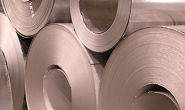Product
January 14, 2013
Natural Gas Changing The Future Of Steel
Written by Sandy Williams
Written by: Sandy Williams
Natural gas is providing cost savings for steel plants while at the same time creating more demand for steel products used in pipelines, drilling equipment and rigs. It is a win-win situation for the steel and the natural gas industries
One of the ways natural gas is utilized by the steel industry is at Direct Reduced Iron (DRI) facilities that directly reduce iron ore by a process that uses a natural gas derivative. The DRI method saves nearly 20 percent in production costs, or about $82 per ton, versus using a traditional blast furnace. Natural gas can also be used for firing the furnaces used for “cooking” coal and to generate electricity to power electric-arc furnaces—and all with a smaller environmental footprint.
This has led to energy partnerships such as between Nucor’s new DRI facility in Louisiana and Canadian energy company EnCana. Nucor’s Louisiana facility initially will convert natural gas and iron ore pellets, along with recycled scrap, to produce an estimated 2.5 million tons of pig iron steel per year that will be shipped to its electric arc furnace mills. Subsequent phases are to include a second DRI plant, coke plant, blast furnace, pellet plant and steel mill.
“We are always searching for ways to improve our competitive position and drive sustained value creation over cycles,” said Nucor’s Chairman and CEO, Dan DiMicco. “The increased exposure to natural gas prices that will accompany our current and potential DRI production, combined with the tremendous advances that have been made in the natural gas industry, have created a unique opportunity to leverage our strong balance sheet to create what we believe will be a lasting competitive advantage for Nucor.”
US Steel uses blast furnaces but, by using natural gas in some phases of production, estimates it can reduce use of coking coal by 10 percent and save $6-$7 per ton of steel. A savings that adds up for a company that produces 23 million tons of steel per year. At their Gary, Indiana plant, US Steel is working to replace 100 pounds of coke per ton of steel produced with natural gas.
At the Clairton plant near Pittsburgh, US Steel partnered with Suncoke Energy to install a new battery of coke ovens that use heat recovery to create a high quality coke. The process also converts waste heat into steam and electricity while incinerating pollutants, eliminating the need for a chemical by-products plant and disposal of hazardous waste. The electricity generated can be used at the plant or transmitted to others for use. Natural gas from Western Pennsylvania is used to keep energy costs down at the facility.
Natural gas prices in 2013 are expected to average $3.70 Btu according to estimates compiled by Bloomberg. The natural gas industry is booming with the development of fracking technology that is being widely used in the Northeast. Fracking is a technique which blows water and sand under high pressure deep into rock, such as shale, which then cracks and allows the natural gas to escape.
“There is a new focus on natgas,” said Larry Kavanagh, president of the American Iron and Steel Institute’s Steel Market Development Institute in MoneyNews. “Until the recent discovery, we believed coal-based technologies would dominate the future. Now the game has changed in the near term.”
John Anton, director of steel services for the global forecasting company IHS, told MoneyNews he believes there is little risk that steel companies will get burned should gas prices rise again. “DRI cannot stand high gas prices; but with fracking technology, we see low prices around $4 lasting for 30 years and under $8 for the next 80 years,” said Anton.
According to the Interstate Natural Gas Association of America (INGAA), more than $20 billion in pipelines will laid between now and 2035 in the Marcellus Shale region in the Northeast U.S. Nationwide more than 461,000 miles of pipeline will be needed, a $169 billion investment that does not even include the infrastructure necessary for compression, processing, storage or natural gas liquids. INGAA predicts a 39 percent growth in the natural gas market by 2035 and shale production, with its need for steel pipeline, will increase by 308 percent to meet the demand.
Greg Ebel, chairman of INGAA and president and CEO of Spectra Energy Corp., expects pipeline construction activity to remain steady for the next few years. “If we see a solid uptick in gas prices, especially in the 2014 and beyond timeframe, this will drive a significant increase in infrastructure development and expansion,” said Ebel in Pipeline & Gas Journal.
Natural gas for high quality steel, energy, cleaner environment, and cost savings, plus the added benefit of selling more steel to the natural gas industry—a perfect pairing for two of America’s biggest industries.







